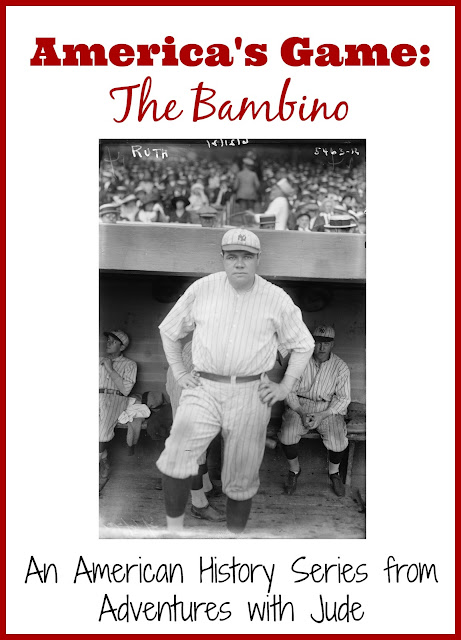Baseball began as an informal game of rounders, and gained popularity during the Civil War era. By the turn of the 20th century, the game had become more organized, with official leagues and teams forming. However, baseball as we remember it now really began in the 1920s when Babe Ruth came to the plate.
George Herman Ruth Jr. on February 6, 1895, in Baltimore, Maryland, and was raised in a poor waterfront neighborhood in Baltimore, A troublemaker as a child, his parents decided 7-year-old Ruth needed more discipline than they could give him. They sent him to St. Mary's Industrial School for Boys, a Catholic orphanage and reformatory that became Ruth's home for the next 12 years. Ruth particularly looked up to a monk named Brother Matthias, who became a father figure to the young Ruth. Mathias introduced Ruth to baseball, a game at which the boy began to excel.
| Babe Ruth (top row, center) at St. Mary's Industrial School for Boys, Maryland - 1913 Public domain, via Wikimedia Commons |
By the time he was 15, Ruth had shown exceptional skill both as a strong hitter and pitcher. It was his pitching that initially caught the attention of Jack Dunn, the owner of the minor league Baltimore Orioles. At the time, the Orioles groomed players for the Boston Red Sox, and Dunn saw promise in Ruth's athletic performance. Only 19, the law at the time stated that Ruth had to have a legal guardian sign his baseball contract for him to play professionally. As a result, Dunn became Ruth's legal guardian, leading teammates to jokingly call Ruth "Dunn's new babe." The joke stuck, and Ruth quickly earned the nickname "Babe" Ruth.
 |
Babe Ruth, publicity photo, 1919, Boston Red Sox
By National Photo Company [Public domain], via Wikimedia Commons |
The deal came to shape both franchises in unforeseen ways. For Boston, Ruth's departure spelled the end of the team's winning streak. It wouldn't be until 2004 that the club would win another World Series, a championship drought that later sportswriters dubbed "The Curse of the Bambino." For the New York Yankees, it was a different matter. With Ruth leading the way, New York turned into a dominant force, winning four World Series titles over the next 15 seasons and racking up home runs. Ruth, who became a full-time outfielder, was at the heart of all the success, unleashing a level of power that had never been seen before in the game.
 |
| Yankee Stadium, New York, main entrancePublic Domain, via Wikipedia Commons |
became known as "the house that Ruth built." Over the course of his career, Ruth went on to break baseball's most important slugging records, including most years leading a league in home runs (12); most total bases in a season (457), and highest slugging percentage for a season (.847). He hit 714 home runs in his career, a mark that stood until 1974 when Hank Aaron of the Atlanta Braves surpassed him. Ruth's success on the field was matched by conduct that catered perfectly to a pre-Depression America hungry for a fast lifestyle. Rumors of his conspicuous appetite for food, alcohol, and women, as well as his tendency toward extravagant spending and high living, were as legendary as his exploits at the plate. This reputation, whether true or imagined, hurt Ruth's chances of becoming a team manager in later life. Ball clubs, wary of his lifestyle, didn't want to take a chance on the seemingly irresponsible Ruth. In 1935, he was lured back to Boston to play for the Braves and the opportunity, so he thought, to manage the club the following season. The job never materialized. On May 25, 1935, an overweight and seemingly diminished Babe Ruth reminded fans of his greatness one last time when hit three home runs in a single game at Forbes Field in Pittsburgh, Pennsylvania. The following week, Ruth officially retired. He was one of the first five players inducted into the Baseball Hall of Fame in 1936.
 |
| Babe Ruth Hall of Fame Plaque Public Domain, via Wikimedia Commons |
While he eventually earned the title of coach for the Brooklyn Dodgers in 1938, Ruth never achieved his goal of managing a major league team. Known throughout his life as a generous man, he gave much of his time in his last years to charitable events instead. On June 13, 1948, he made one final appearance at Yankee Stadium to celebrate the building's 25th anniversary. Sick with cancer, Ruth had become a shadow of his former, gregarious self. Two months later, on August 16, 1948, Babe Ruth died, leaving much of his estate to the Babe Ruth Foundation for underprivileged children.

Click here to read other posts in the series!
©2012- 2016 Adventures with Jude. All rights reserved. All text, photographs, artwork, and other content may not be reproduced or transmitted in any form without the written consent of the author. http://adventureswithjude.com


No comments:
Post a Comment